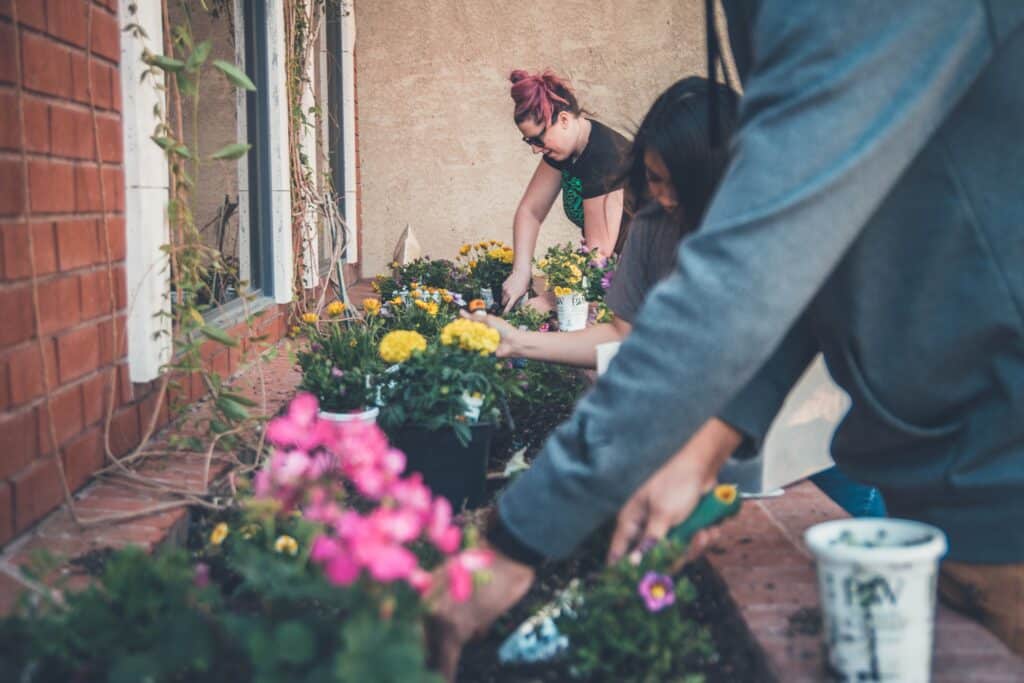
95 Spring Words in Spanish [With Audio]
La primavera (spring) is the perfect time to grow your vocabulary.
As the world awakens from its winter slumber, nature unfolds a vibrant tapestry of colors and scents, announcing the arrival of spring.
In this post, you’ll learn 95 words and phrases related to the spring season.
From blossoming flowers to the buzzing of bees, these spring words in Spanish paint a vivid picture of the season.
Contents
- General Spring Vocabulary
- Flower Parts and Types
- Spring Verbs in Spanish
- Spanish Adjectives to Describe Spring
- Vocabulary for Talking About Allergies
- How to Practice Spring Words in Spanish
- And One More Thing…
Download: This blog post is available as a convenient and portable PDF that you can take anywhere. Click here to get a copy. (Download)
General Spring Vocabulary
These words and phrases will jumpstart your spring vocabulary in Spanish:
Flower Parts and Types

In most places, flowers go hand in hand with spring. Here’s some vocabulary for the different flower parts and kinds of flowers:
| Spanish | English |
|---|---|
| el capullo | bud |
| la hoja | leaf |
| el tallo | stem |
| la raíz | root |
| el pétalo | petal |
| la semilla / la simiente | seed |
Now that you’ve learned the individual flower parts, you can grow your vocabulary by naming specific flowers in Spanish. Many flower names are English-Spanish cognates; that is, they’re the same or similar in both languages (like rosa — rose).
| Spanish | English |
|---|---|
| la rosa | rose |
| el girasol | sunflower |
| la margarita | daisy |
| el lirio | lily |
| el tulipán | tulip |
| la violeta | violet |
| el clavel | carnation |
| la orquídea | orchid |
| el jazmín | jasmine |
| la amapola | poppy |
| el narciso | daffodil |
| el iris | iris |
Spring Verbs in Spanish

Having nouns without verbs is like planting seeds without water. Here are some useful spring action words that’ll help your vocabulary bloom:
| Verb | Example |
|---|---|
| crecer (to grow, increase) | El girasol crece bajo el sol. (The sunflower grows under the sun.) |
| florecer (to blossom) | Las rosasflorecen en primavera. (Roses blossom in spring.) |
| abrirse (to open up) | Cada día los pétalos de las prímulas se abren. (Every day the petals of the primroses open.) *Note that this is a reflexive verb. |
| cavar (to dig) | Cava el agujero aquí, por favor. (Dig the hole here, please.) |
| regar (to water) | Es importante que riegues las plantas. (It's important that you water the plants.) |
| plantar (to plant) | Planté las margaritas y las amapolas cerca del árbol. (I planted daisies and poppies close to the tree.) |
| germinar (germinate) | Las semillas comenzaron a germinar después de las lluvias constantes. (The seeds started to germinate after the constant rains.) |
| brotar, retoñar (to sprout) | Las semillas brotan de la tierra.
(The seeds sprout from the earth.) El arce japonés brota hojas rojas. (The Japanese maple sprouts red leaves.) |
| desarrollarse (to develop) | Los brotes comienzan a desarrollarse en ramas y arbustos. (Sprouts begin to develop on branches and bushes.) |
| renacer (to be reborn) | La naturaleza renace con nueva vida durante la primavera. (Nature is reborn with new life during spring.) |
| despertar (to awaken) | Las flores y plantas comienzan a despertar del sueño invernal. (Flowers and plants begin to wake up from winter sleep.) |
| renovar (to renew) | La primavera trae consigo la oportunidad de renovar jardines y paisajes. (Spring brings with it the opportunity to renew gardens and landscapes.) |
| cantar (to sing) | Los pájaros cantan melodías alegres en la primavera. (Birds sing happy tunes in the spring.) |
| disfrutar (to enjoy) | La gente sale a disfrutar del buen tiempo primaveral al aire libre. (People go out to enjoy the good spring weather outdoors.) |
You can’t use these verbs as is, of course. For some help conjugating any of these words, head over to SpanishDict’s conjugation dictionary or review our post on conjugating Spanish verbs.
Spanish Adjectives to Describe Spring

Let’s make your vocabulary garden grow even more by adding some descriptive words. Remember that Spanish adjectives must agree in gender and number (singular or plural) with the noun they’re describing, and typically go after the noun.
| Adjective | Example |
|---|---|
| brillante (bright, vibrantly-colored) | El lirio anaranjado tiene pétalos brillantes. (The orange iris has bright petals.) |
| verde (verdant) | Las yerbas del prado son verdes y suaves. (The meadow grasses are verdant and soft.) |
| espléndido (glorious) | El estanque con lirios acuáticos, ranas y peces es espléndida. (The pond with waterlilies, frogs and fish is glorious.) |
| resistente (hardy) | Ese diente de león es la peor mala hierba porque es muy resistente. (That dandelion is the worst weed because it's very hardy.) |
| exuberante, lozano (lush) | El parque tiene muchos arboles y flores lozanos. (The park has many lush trees and flowers.) |
| frondoso (leafy) | La hortensia es una flor verde y frondosa. (The hydrangea is a verdant and leafy flower.) |
| florido (flowered) | Los campos se ponen floridos con la llegada de la primavera. (The fields become flowery with the arrival of spring.) |
| colorido (colorful) | La primavera trae consigo un paisaje colorido y vibrante. (Spring brings with it a colorful and vibrant landscape.) |
| fresco (fresh) | El aire primaveral es fresco y rejuvenecedor. (The spring air is fresh and rejuvenating.) |
| soleado (sunny) | Los días primaverales suelen ser soleados y agradables. (Spring days are usually sunny and pleasant.) |
| renovador (renewing) | La primavera tiene un efecto renovador en la naturaleza. (Spring has a renewing effect on nature.) |
| vibrante (vibrant) | La vida vuelve de manera vibrante con la llegada de la primavera. (Life returns vibrantly with the arrival of spring.) |
| alegre (cheerful) | El ambiente primaveral es alegre y lleno de energía positiva. (The spring atmosphere is happy and full of positive energy.) |
| cálido (warm) | Las temperaturas se vuelven cálidas durante la primavera. (Temperatures become warm during spring.) |
| perfumado (fragrant) | La primavera trae consigo aromas perfumados de flores y plantas. (Spring brings with it fragrant aromas of flowers and plants.) |
| encantador (enchanting) | La primavera crea un entorno encantador y mágico. (Spring creates an enchanting and magical environment.) |
Vocabulary for Talking About Allergies

Many people around the world love spring, but there’s one group of people who aren’t as friendly with the beautiful season: alérgicos (allergy sufferers)!
If you suffer from allergies, you can use these words to express your misery in Spanish:
| Vocabulary Word | Example |
|---|---|
| la alergia primaveral (spring allergy) | Mi alergia primaveral se despierta con la floración de las plantas. (My spring allergy wakes up with the flowering of plants.) |
| el polen (pollen) | Las abejas aman el polen, pero los alérgicos lo odian. (Bees love pollen, but allergy sufferers hate it.) |
| estornudar (to sneeze) | No sé quién estornuda más, mi perro o mi gato. (I don't know who sneezes more, my dog or my cat.) |
| sorberse (to sniffle) | Cuando fui al arboreto, me sorbí la nariz. (When I went to the arboretum, I sniffled.) |
| resollar (to wheeze, to breathe heavily) | Los alérgicos resuellan porque el viento sopla el polen y la caspa. (Allergy sufferers wheeze because the wind blows pollen and dander.) |
| taponado, tapado, (stuffy, congested) | Tengo la nariz tapada. (My nose is stuffy.) |
| la congestión nasal (nasal congestion) | La congestión nasal es una molestia común durante la primavera. (Nasal congestion is a common complaint during spring.) |
| el picor de ojos (itchy eyes) | El picor de los ojos me hace difícil disfrutar de la primavera. (Itchy eyes make it difficult for me to enjoy spring.) |
| la tos (cough) | La tos persistente es otra consecuencia de mi alergia a la primavera. (The persistent cough is another consequence of my spring allergy.) |
| el malestar general (general discomfort) | Experimento malestar general durante la temporada de alergias primaverales. (I experience general discomfort during spring allergy season.) |
| el goteo nasal (runny nose) | El goteo nasal es un signo claro de mi reacción al polen en primavera. (A runny nose is a clear sign of my reaction to pollen in spring.) |
| la fatiga (fatigue) | La fatiga se apodera de mí debido a la lucha constante contra los síntomas alérgicos. (Fatigue sets in due to the constant fight against allergic symptoms.) |
| los medicamentos antialérgicos (anti-allergy medications) | Los medicamentos antialérgicos son mi salvación para controlar los síntomas en primavera. (Anti-allergy medications are my salvation to control symptoms in spring.) |
How to Practice Spring Words in Spanish

Now that you’re equipped with some spring words and phrases in Spanish, it’s time to put them into practice! Here are a few ways you can use your spring vocabulary:
- Look for your new vocabulary words on FluentU, where videos about many topics (including nature and seasons) are supported by learning tools.
FluentU takes authentic videos—like music videos, movie trailers, news and inspiring talks—and turns them into personalized language learning lessons.
You can try FluentU for free for 2 weeks. Check out the website or download the iOS app or Android app.
P.S. Click here to take advantage of our current sale! (Expires at the end of this month)

- Take a walk at a local arboretum, nature trail or park. Bring along your partner, children or friends and see if you can identify the flower parts and the specific flowers in Spanish correctly.
If you see more flowers and other plants you recognize but don’t know the Spanish word for, you can create your own flower and plant list.
- Test out your green thumb. Visit your local nursery or garden supply shop, locate the flowers you learned about here and plant them. Be sure to test out your Spanish verbs while caring for the flowers!
- Take photos of all these lovely flowers, post them online and then label all of them with your new Spanish words. Impress your friends by knowing the flower and plant names in another language, or join a Spanish-speaking community of plant lovers.
Everyone can enjoy this beautiful season, and now you have the Spanish spring words to reinforce your language learning while you do it!
For even more nature-related vocabulary, visit this post next:
125 Nature Words in Spanish [With Audio] | FluentU Spanish Blog
Nature words in Spanish are a key element of everyday vocabulary. The environment is a part of our daily lives and our constant surroundings, so it comes up a lot in…
Download: This blog post is available as a convenient and portable PDF that you can take anywhere. Click here to get a copy. (Download)
And One More Thing…
If you've made it this far that means you probably enjoy learning Spanish with engaging material and will then love FluentU.
Other sites use scripted content. FluentU uses a natural approach that helps you ease into the Spanish language and culture over time. You’ll learn Spanish as it’s actually spoken by real people.
FluentU has a wide variety of videos, as you can see here:

FluentU brings native videos within reach with interactive transcripts. You can tap on any word to look it up instantly. Every definition has examples that have been written to help you understand how the word is used. If you see an interesting word you don’t know, you can add it to a vocab list.

Review a complete interactive transcript under the Dialogue tab, and find words and phrases listed under Vocab.

Learn all the vocabulary in any video with FluentU’s robust learning engine. Swipe left or right to see more examples of the word you’re on.

The best part is that FluentU keeps track of the vocabulary that you’re learning, and gives you extra practice with difficult words. It'll even remind you when it’s time to review what you’ve learned. Every learner has a truly personalized experience, even if they’re learning with the same video.
Start using the FluentU website on your computer or tablet or, better yet, download the FluentU app from the iTunes or Google Play store. Click here to take advantage of our current sale! (Expires at the end of this month.)



